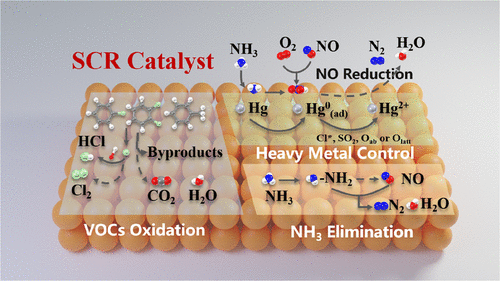当前位置:
X-MOL 学术
›
Environ. Sci. Technol.
›
论文详情
Our official English website, www.x-mol.net, welcomes your
feedback! (Note: you will need to create a separate account there.)
Multipollutant Control (MPC) of Flue Gas from Stationary Sources Using SCR Technology: A Critical Review
Environmental Science & Technology ( IF 10.8 ) Pub Date : 2021-02-11 , DOI: 10.1021/acs.est.0c07326 Dong Wang 1, 2 , Qiuzhun Chen 3 , Xiang Zhang 3 , Chuan Gao 3 , Bin Wang 3 , Xu Huang 1 , Yue Peng 1 , Junhua Li 1 , Chunmei Lu 3 , John Crittenden 2
Environmental Science & Technology ( IF 10.8 ) Pub Date : 2021-02-11 , DOI: 10.1021/acs.est.0c07326 Dong Wang 1, 2 , Qiuzhun Chen 3 , Xiang Zhang 3 , Chuan Gao 3 , Bin Wang 3 , Xu Huang 1 , Yue Peng 1 , Junhua Li 1 , Chunmei Lu 3 , John Crittenden 2
Affiliation

|
The emission of gaseous pollutants from the combustion of fossil fuels is believed to be one of the most serious environmental challenges in the 21st century. Given the increasing demands of multipollutant control (MPC) via adsorption or catalysis technologies, such as NOx, volatile organic compounds (VOCs), heavy metals (Hg etc.), and ammonia, and considering investment costs and site space, the use of existing equipment, especially the selective catalytic reduction (SCR) system to convert pollutants into harmless or readily adsorbed substances, is one of the most practical approaches. Consequently, many efforts have been directed at achieving the simultaneous elimination of multipollutants in a SCR convertor, and this method has been widely used to mitigate the stationary emission of NOx. However, the development of active, selective, stable, and multifunctional catalysts/adsorbents suitable for large-scale commercialization remains challenging. Herein, we summarize recent works on the applications of SCR in MPC, describing the approaches of (i) SCR + VOCs oxidation, (ii) SCR + heavy metal control, and (iii) SCR + NH3 reduction to reveal that the efficiency of simultaneous elimination depends on catalyst composition and flue gas parameters. Furthermore, the synergistic promotional/inhibitory effects between SCR and VOCs/ammonia/heavy metal oxidations are shown to be the key to the feasibility of the reactions.
中文翻译:

使用SCR技术的固定源烟气多污染物控制(MPC):一项重要评论
化石燃料燃烧产生的气体污染物排放被认为是21世纪最严重的环境挑战之一。鉴于通过吸附或催化技术(如NO x,挥发性有机化合物(VOCs),重金属(Hg等)和氨水)对多污染物控制(MPC)的需求不断增加,并考虑到投资成本和场地空间,使用现有设备,特别是将污染物转化为无害或易于吸附的物质的选择性催化还原(SCR)系统,是最实用的方法之一。因此,已经进行了许多努力来实现在SCR转换器中同时消除多种污染物,并且该方法已被广泛用于减轻NO x的固定排放。。然而,适合大规模商业化的活性,选择性,稳定和多功能催化剂/吸附剂的开发仍然具有挑战性。在这里,我们总结了最近在SCR在MPC中的应用的工作,描述了(i)SCR + VOCs氧化,(ii)SCR +重金属控制和(iii)SCR + NH 3还原的方法,揭示了SCR的效率。同时消除取决于催化剂组成和烟气参数。此外,SCR和VOC /氨/重金属氧化之间的协同促进/抑制作用被证明是反应可行性的关键。
更新日期:2021-03-02
中文翻译:

使用SCR技术的固定源烟气多污染物控制(MPC):一项重要评论
化石燃料燃烧产生的气体污染物排放被认为是21世纪最严重的环境挑战之一。鉴于通过吸附或催化技术(如NO x,挥发性有机化合物(VOCs),重金属(Hg等)和氨水)对多污染物控制(MPC)的需求不断增加,并考虑到投资成本和场地空间,使用现有设备,特别是将污染物转化为无害或易于吸附的物质的选择性催化还原(SCR)系统,是最实用的方法之一。因此,已经进行了许多努力来实现在SCR转换器中同时消除多种污染物,并且该方法已被广泛用于减轻NO x的固定排放。。然而,适合大规模商业化的活性,选择性,稳定和多功能催化剂/吸附剂的开发仍然具有挑战性。在这里,我们总结了最近在SCR在MPC中的应用的工作,描述了(i)SCR + VOCs氧化,(ii)SCR +重金属控制和(iii)SCR + NH 3还原的方法,揭示了SCR的效率。同时消除取决于催化剂组成和烟气参数。此外,SCR和VOC /氨/重金属氧化之间的协同促进/抑制作用被证明是反应可行性的关键。











































 京公网安备 11010802027423号
京公网安备 11010802027423号